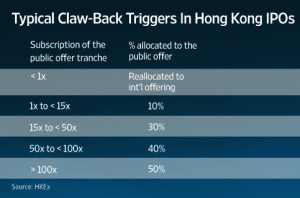HONG KONG (Dow Jones Investment Banker) – Claw-back rules for retail tranches in Hong Kong IPOs are a unique feature of that market. They bring an element of fairness between institutions and the general public; however, retail investors have increasingly shunned new issues and also now account for a smaller proportion of secondary trading, as compared with a few years ago. Now might perhaps be a good time to rethink those provisions, and to grant more flexibility to ECM bankers and issuers to allocate books of demand.
Stock exchanges require a minimum spread of shareholders upon listing, so as to ensure adequate liquidity in the aftermarket. In Tokyo, the rules call for a minimum of 2,200 shareholders, while in Singapore that requirement is for 500 only. In Hong Kong, this is now 300 (the number previously varied between 300 and 1,000 shareholders, depending on financial criteria met by issuers).
In most cases, the only way to attain that threshold is to conduct a retail offering. Except in Japan, where IPOs are mostly exclusively distributed to high net worth individuals, these are generally kept at a relatively low level. There are good reasons for this. Retail investors are generally not long-term shareholders: their presence usually brings volatility to aftermarket trading.
The rules in Hong Kong are unique, in that they include a claw-back, pursuant to which the size of the retail tranche varies, depending on how its initial amount has been oversubscribed. In simple terms, pretty much all IPOs there start with a 10% retail tranche, but that percentage can increase up to 50% in a very hot deal.

No doubt originally drafted with fairness in mind, those rules are pretty arbitrary and do not take into account the profile of a deal, or whether an IPO is particularly suited to significant investment by the general public.
Hong Kong has in recent years become the most active market globally for IPO funds raised. These totaled more than US$24 billion between January and August 2011, an increase of 26% as compared with the same period in 2010 according to HKEx. That’s really a function of the continuing stream of Chinese issuers seeking to raise capital there. More than 55% of the companies listed in Hong Kong by value (and 42% by number) come from the Mainland. These are also the most actively traded stocks, accounting for almost 70% of the exchange’s turnover.
Queues to apply for hot IPOs outside bank branches are – or at least were – relatively frequent in Hong Kong. But the share of deals taken up by the general public there has been declining. An analysis conducted in the first half of this year showed that retail tranches had, bar a handful of exceptions, been poorly subscribed.
[ Click HERE for my DJIB column “Hong Kong Retail Investors Give IPOs A Miss” published on 13 June 2011]
Even more telling, the share of local retail investors in secondary market trading has dropped from 32% in 2001-02 to 21.3% in 2009-10, according to data compiled by HKEx.
| Percentage of market trading by retail investors in Hong Kong: | ||||
| 2001-02: | 32.0% | |||
| 2002-03: | 30.0% | |||
| 2003-04: | 34.0% | |||
| 2004-05: | 27.0% | |||
| 2005-06: | 27.0% | |||
| 2006-07: | 27.5% | |||
| 2007-08: | 25.9% | |||
| 2008-09: | 25.2% | |||
| 2009-10: | 21.3% | |||
| Source: HKEx | ||||
The exchange and Hong Kong’s regulator, the Securities and Futures Commission (SFC), recognize the danger of going overboard with retail tranches, and routinely grant waivers from the claw-back provisions in the case of very large transactions. In the US$22.1 billion IPO of Agricultural Bank of China Limited, the initial size of the retail tranche was only 5% and the claw-back could only take it to a maximum of 20%. Similar provisions were included in the US$10 billion IPO of Glencore International plc, taking the initial retail offering from 2.5% to 10%. And in 2009’s US$2.2 billion IPO of United Company RUSAL, retail investors were pretty much excluded from participating altogether, as a very high board lot was imposed.
Doing away with Hong Kong’s IPO claw-back rules would take at least six months. Consultation papers would need to be drafted and circulated, market participants’ responses analyzed, and consultation conclusions published, for further approval by HKEx’s board and the SFC. It would also no doubt face stiff opposition on the part of receiving banks and retail brokers, who earn interest on IPO application moneys (which are payable in advance), as well as through margin loans.
However, over time this could also make Hong Kong a more mature and less volatile market, and provide bookrunners and their clients with much-needed flexibility to allocate stock, especially in challenging market conditions.
(Philippe Espinasse worked as an investment banker in the U.S., Europe and Asia for more than 19 years and now writes and works as an independent consultant in Hong Kong. Visit his website at https://www.ipo-book.com. Readers should be aware that Philippe may own securities related to companies he writes about, may act as a consultant to companies he mentions and may know individuals cited in his articles. To comment on this column, please email [email protected]).
[This article was originally published on Dow Jones Investment Banker on 13 September 2011 and is reproduced with permission.]
Copyright (c) 2011, Dow Jones & Company, Inc.
